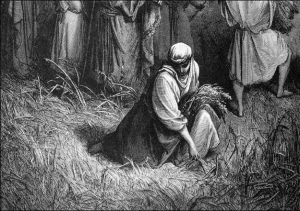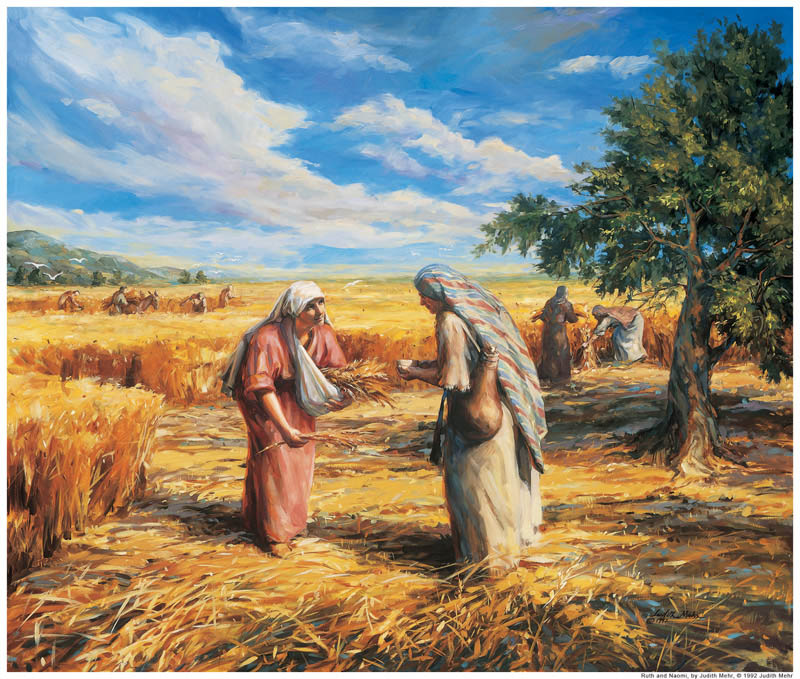 The Book of Ruth appears to be intended to connect the history of David with the earlier times, and also to form a contrast, in its peaceful and pastoral simplicity, to the disorders of which we read so continually in the Book of Judges.
The Book of Ruth appears to be intended to connect the history of David with the earlier times, and also to form a contrast, in its peaceful and pastoral simplicity, to the disorders of which we read so continually in the Book of Judges.
“Many years had passed since the Israelites had crossed the Jordan and formed a loose tribal confederacy in the central highlands of Canaan. As they established their own settlements, they gradually discarded their nomadic traditions and adopted an agricultural way of life.
“Yet their position remained precarious. The northern tribes were almost constantly at war with those walled cities that remained under the control of the Canaanites, and they frequently had to defend themselves against invasions by people from the east: the Ammonites and Midianites. In contrast, Judah, which occupied the southern end of the Israelite territory, seems to have been relatively tranquil and not involved in the great wars that concerned the Judges.
“The people of Judah regularly battled another sort of enemy: the climate. Judah occupied a rugged plateau in the semiarid lands west of the Dead Sea. Normally, the land was fertile enough to sustain fields of wheat and barley, grape vineyards and groves of olive and fig trees. But occasionally the rains failed, the crops withered and there was famine.
“During one such disaster, a Judean man named Elimelech, who lived in the town of Bethlehem, fled the land with his wife, Naomi, and their two sons, Mahlon and Chilion. The familytraveled to Moab, a kingdom on the eastern borders of the Dead Sea. The distance was not great—perhaps 30 or 40 miles along the edge of that inland sea [the Dead Sea].” ( Great People of the Bible and How They Lived, p. 126.)
The two sons of Elimelech took wives of the Moabites. The central god of the Moabites was Chemosh, but the account does not say whether Ruth and Orpah were believers in the pagan deity or not. However, we do know from the account that Ruth converted to the Israelite faith.
The famine enlarged in the area, and soon Naomi had lost her husband and both sons. She encouraged her two daughters-in-law to return to the familiesfrom which they had come. Both resisted, but Orpah finally relented, while Ruth was determined to stay with Naomi and follow her back to Bethlehem in Judah. Her famous words are found in Ruth 1: 16, 17: “Intreat me not to leave thee, orto return from following after thee: for whither thou goest, I will go; and where thou lodgest, I will lodge: thy people shall bemy people, and thy God my God: Where thou diest, will I die, and there will I be buried: the Lord do so to me, and more also, if ought but death part thee and me.” These words of loyalty and love are so moving, that they have been used in modern marriage vows.
Naomi, whose name means “pleasant,” returned to Bethlehem a bitter woman because of her loss. She mourned before her interested neighbors and bid them call her “mara,” or “bitter.” The Lord was watching over these faithful women, however, and restored them to some happiness.
Ruth went to glean in the fields of a wealthy relative of Naomi’s:
“Harvesting was difficult work and demanded long hours. Young men moved through the fields grasping handfuls of the grain and cutting through the stalks with sickles. These small bunches of grain were then bound into bundles called sheaves. As the men worked rapidly, a number of stalks fell to the ground. If the men were careful and took the time, these too could be gathered up. However, any stalks that dropped were allowed to remain where they fell. Poor people, following the reapers, were permitted to ‘glean,’ or gather, the random stalks—possibly all that stood between them and starvation. In addition, the edges of the field, where the sickle was not as easily wielded, were left unharvested. The poor were welcome to that portion, as well.
“The destitute of Bethlehem now included Ruth and Naomi, and Ruth offered to go into the fields and glean.” ( Great People of the Bible and How They Lived, p. 129.)
 Naomi wanted to help her faithful daughter-in-law secure a husband and family. To do this, Naomi considered the levirate marriage, a practice that had prevailed for many years in Israel. The law of levirate marriage was meant to provide for widows and their children. When a man died, it was the obligation of his brother to marry and care for the widow. If there were no children, then this provided a way for progeny to be produced with the family name. If there were children, then they could be cared for. If the oldest brother could not follow through with the responsibility, he could bow out, and a younger brother could step up, on down through ever more distant relatives.
Naomi wanted to help her faithful daughter-in-law secure a husband and family. To do this, Naomi considered the levirate marriage, a practice that had prevailed for many years in Israel. The law of levirate marriage was meant to provide for widows and their children. When a man died, it was the obligation of his brother to marry and care for the widow. If there were no children, then this provided a way for progeny to be produced with the family name. If there were children, then they could be cared for. If the oldest brother could not follow through with the responsibility, he could bow out, and a younger brother could step up, on down through ever more distant relatives.
Boaz would become a go’el for Ruth and Naomi. Though the King James Version translates this word as “kinsman,” it really means “redeemer.” Each of us can be a go’el for another person, if we perform some act during this life that saves another, as Boaz saves Ruth. Of course, in the infinite sense, only Christis the go’el for all mankind.
“It is easy to see why the later prophets borrowed this word from the social laws of Israel and used it to describe the functions of Him who would become the Divine Redeemer: Think of what He does to restore us to proper status with God, and to give us future security and eternal ‘seed.’” (Rasmussen, Introduction to the Old Testament, 1:157.)
In Ruth 3:6–9 Ruth proposes to Boaz by lying near him while he sleeps near his harvest of grain. Of course, her behavior is direct. However, Gesenius, the famous Hebraist, says it was a proper proposal of marriage—even though the girl was doing the proposing!” (Rasmussen, Introduction to the Old Testament, 1:157.)
“Boaz, who was an honourable man, and, according to [ Ruth 3:10 ], no doubt somewhat advanced in years, praised Ruth for having taken refuge with him, and promised to fulfil her wishes when he had satisfied himself that the nearer redeemer would renounce his right and duty [see vv. 10–11 ]. As he acknowledged by this very declaration, that under certain circumstances it would be his duty as redeemer to marry Ruth, he took no offence at the manner in which she had approached him and proposed to become his wife. On the contrary, he regarded it as a proof of feminine virtue and modesty, that she had not gone after young men, but offered herself as a wife to an old man like him. This conduct on the part of Boaz is a sufficient proof that women might have confidence in him that he would do nothing unseemly. And he justified such confidence.” (Keil and Delitzsch, Commentary, 2:1:483.)
“The public life of an Israelite village was concentrated at its main gate. It was here that matters of law were brought for adjudication before the elders of the community. They also were the official witnesses for transactions such as the one in which Boaz agreed to marry Ruth if her kinsman would give up all rights to her dead husband’s property. A man renouncing property rights removed a sandal and presented it to the new property holder, a gesture that everyone understood and considered binding if witnessed by the elders.” ( Great People of the Bible and How They Lived, p. 133.)
At the end of the Book of Ruth, we see that David would come from her lineage. That the Lord would look favorably upon a Moabitess, enough to make her the mother of such an illustrious royal line, from which Christ Himself would come, shows that the Lord loves all of His children equally, and that He looks upon the heart and not the outward countenance.
*This article was adapted from the LDS Old Testament Institute Manual.
Next: Samuel and Saul
